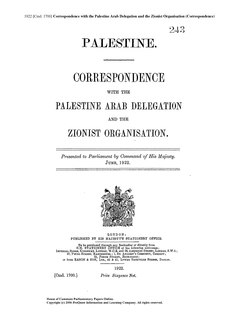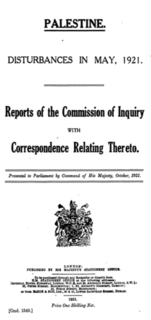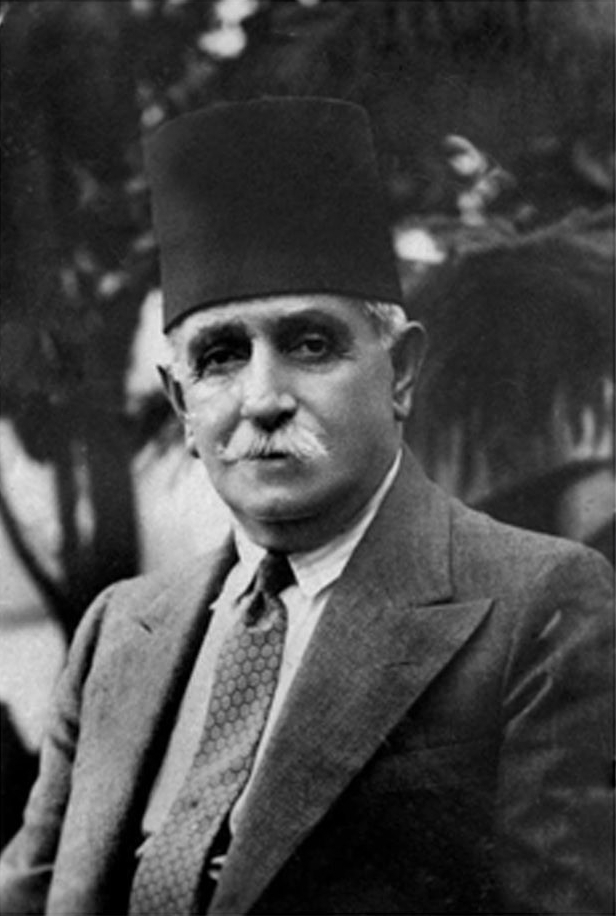Related Research Articles

Mohammed Amin al-Husseini was a Palestinian Arab nationalist and Muslim leader in Mandatory Palestine.

The Churchill White Paper of 3 June 1922 was drafted at the request of Winston Churchill, then Secretary of State for the Colonies, partly in response to the 1921 Jaffa Riots. The official name of the document was Palestine: Correspondence with the Palestine Arab Delegation and the Zionist Organisation. The white paper was made up of nine documents and "Churchill's memorandum" was an enclosure to document number 5. While maintaining Britain's commitment to the Balfour Declaration and its promise of a Jewish national home in Mandatory Palestine, the paper emphasized that the establishment of a national home would not impose a Jewish nationality on the Arab inhabitants of Palestine. To reduce tensions between the Arabs and Jews in Palestine the paper called for a limitation of Jewish immigration to the economic capacity of the country to absorb new arrivals. This limitation was considered a great setback to many in the Zionist movement, though it acknowledged that the Jews should be able to increase their numbers through immigration rather than sufferance.

The 1920 Nebi Musa riots or 1920 Jerusalem riots took place in British-controlled part of Occupied Enemy Territory Administration between Sunday, 4 April, and Wednesday, 7 April 1920 in and around the Old City of Jerusalem. Five Jews and four Arabs were killed, and several hundred were injured. The riots coincided with and are named after the Nebi Musa festival, which was held every year on Easter Sunday, and followed rising tensions in Arab-Jewish relations. The events came shortly after the Battle of Tel Hai and the increasing pressure on Arab nationalists in Syria in the course of the Franco-Syrian War.

The Jaffa riots were a series of violent riots in Mandatory Palestine on May 1–7, 1921, which began as a fight between two Jewish groups but developed into an attack by Arabs on Jews. The rioting began in Jaffa and spread to other parts of the country. The riot resulted in the deaths of 47 Jews and 48 Arabs, 146 Jews and 73 Arabs were wounded, and hundreds more were made homeless.

The Haycraft Commission of Inquiry was a Royal Commission set up to investigate the Jaffa riots of 1921, but its remit was widened and its report entitled "Palestine: Disturbances in May 1921". The report blamed the Arabs for the violence, but identified a series of grievances concerning the way their interests were apparently being subsumed to the interests of the Jewish immigrants, who were then around 10% of the population and increasing rapidly. Some measures to ease Arab unhappiness were taken, but Jewish communities were helped to arm themselves and ultimately the report was ignored. Publishing it was considered a propitiatory measure.
The Palestinian people are an Arabic-speaking people with family origins in the region of Palestine. Since 1964, they have been referred to as Palestinians, but before that they were usually referred to as Palestinian Arabs. During the period of the British Mandate, the term Palestinian was also used to describe the Jewish community living in Palestine. The Arabic-language newspaper Falastin (Palestine) was founded in 1911 by Palestinian Christians.

The intercommunal conflict in Mandatory Palestine was the civil, political and armed struggle between Palestinian Arabs and Jewish Yishuv during the British rule in Mandatory Palestine, beginning from the violent spillover of the Franco-Syrian War in 1920 and until the onset of the 1948 Arab–Israeli War.
Muslim supporters of Israel refers to both Muslims and cultural Muslims who support the right to self-determination of the Jewish people and the likewise existence of a Jewish homeland in the Southern Levant, traditionally known as the Land of Israel and corresponding to the modern polity known as the State of Israel. Muslim supporters of the Israeli state are widely considered to be a rare phenomenon in light of the ongoing Israeli–Palestinian conflict and the larger Arab–Israeli conflict. Within the Muslim world, the legitimacy of the State of Israel has been challenged since its inception, and support for Israel's right to exist is a minority orientation. Pro-Israel Muslims have faced opposition from both moderate Muslims and Islamists, with many being subjected to harassment, threats and violence.
Army of Shadows: Palestinian Collaboration with Zionism, 1917–1948 is a book published in 2004 by Hillel Cohen. It is about the sale of land and other co-operation between Arabs and Jews in Palestine before the establishment of the State of Israel.

The Hebron massacre refers to the killing of sixty-seven or sixty-nine Jews on 24 August 1929 in Hebron, then part of Mandatory Palestine, by Arabs incited to violence by rumors that Jews were planning to seize control of the Temple Mount in Jerusalem. The event also left scores seriously wounded or maimed. Jewish homes were pillaged and synagogues were ransacked. Some of the 435 Jews who survived were hidden by local Arab families, although the extent of this phenomenon is debated. Soon after, all Hebron's Jews were evacuated by the British authorities. Many returned in 1931, but almost all were evacuated at the outbreak of the 1936–39 Arab revolt in Palestine. The massacre formed part of the 1929 Palestine riots, in which a total of 133 Jews and 110 Arabs were killed, the majority of the latter by British police and military, and brought the centuries-old Jewish presence in Hebron to an end.
Racism in the Palestinian territories encompasses all forms and manifestations of racism experienced in the Palestinian Territories, of the West Bank, Gaza, and East Jerusalem, irrespective of the religion, colour, creed, or ethnic origin of the perpetrator and victim, or their citizenship, residency, or visitor status. It may refer to Jewish settler attitudes regarding Palestinians as well as Palestinian attitudes to Jews and the settlement enterprise undertaken in their name.

Events in the year 1920 in British-administered Palestine.

Hassan Bey Shukri was the mayor of Haifa and the president of the Muslim National Associations.
Sheikh Musa Hadeib was the head of Mount Hebron farmers' party and a founder of the Zionist-supported Muslim National Associations. He was from the village of Dawaymeh near Hebron.
The Palestine Arab Congress was a series of congresses held by the Palestinian Arab population, organized by a nationwide network of local Muslim-Christian Associations, in the British Mandate of Palestine. Between 1919 and 1928, seven congresses were held in Jerusalem, Jaffa, Haifa and Nablus. Despite broad public support their executive committees were never officially recognised by the British, who said they were unrepresentative. After the British defeat of Ottoman forces in 1918, the British established military rule and (later) civil administration of Palestine. The Palestine Arab Congress and its organizers in the Muslim-Christian Associations were formed when the country's Arab population began coordinated opposition to British policies.
In 1918, following the British defeat of the Ottoman army and their establishment of a Military Government in Palestine, a number of political clubs called Muslim-Christian Associations were established in all the major towns. They soon formed a national body, the Palestine Arab Congress, which tried to influence the developing British policy in Palestine and counter the influence of the Zionist Commission which visited Palestine in April 1918. The main platform of these groups were:

Mandatory Palestine was a geopolitical entity established between 1920 and 1948 in the region of Palestine under the terms of the League of Nations Mandate for Palestine.
This is a timeline of intercommunal conflict in Mandatory Palestine.

Palestinian nationalism is the national movement of the Palestinian people that espouses self-determination and sovereignty over the region of Palestine. Originally formed in opposition to Zionism, Palestinian nationalism later internationalized and attached itself to other ideologies; it has thus rejected the occupation of the Palestinian territories by the government of Israel since the 1967 Six-Day War, and the preceding non-domestic Arab occupations over the Gaza Strip and the West Bank additionally had opposition. Palestinian nationalists often drawn upon broader political traditions in their ideology, examples being Arab socialism and ethnic nationalism in the context of Muslim religious nationalism. Related beliefs have shaped the government of Palestine and continue to do so.
References
- 1 2 3 Huneidi, Sahar (2001). A Broken Trust: Sir Herbert Samuel, Zionism and the Palestinians 1920–1925. London: I.B. Tauris. p. 173. ISBN 1-86064-172-5.
- ↑ Hassassian, Manuel (2005). "Development of the Palestinian National Movement 1919–1939". In Scham, Paul (ed.). Shared Histories: A Palestinian-Israeli Dialogue. Walnut Creek, Calif: Left Coast Press. p. 98. ISBN 1-59874-013-X.
- ↑ The Tangled Truth, by Benny Morris, The New Republic; 7/5/08[ clarification needed ]
- ↑ Cohen, Hillel Army of Shadows: Palestinian collaboration with Zionism, 1917–1948 . Berkeley: University of California Press, 2009. p. 15–17